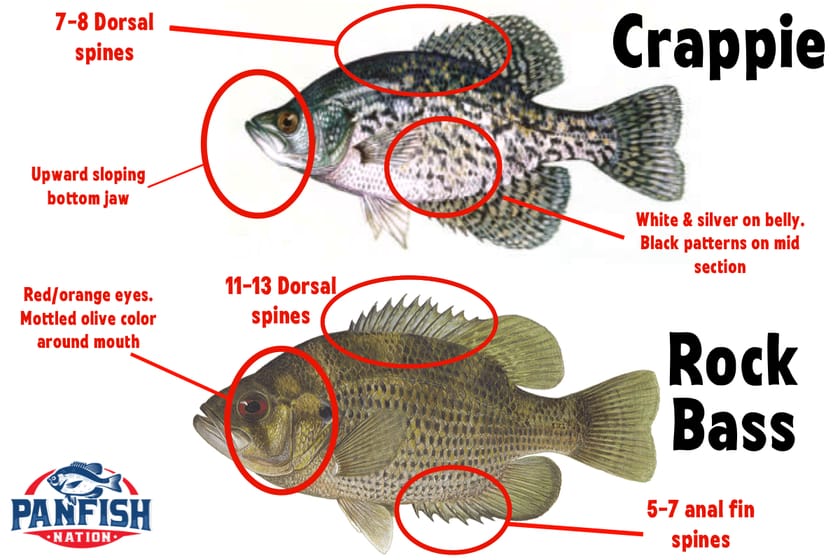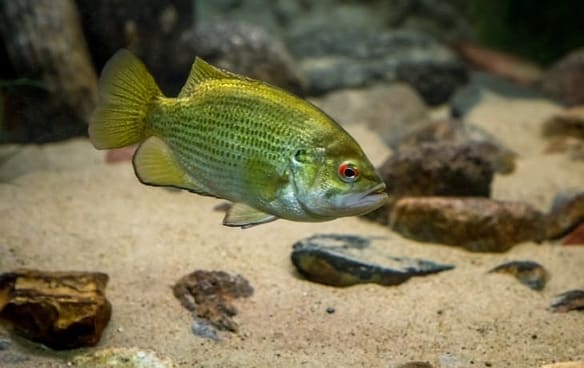Crappie and rock bass are two common catches among freshwater anglers.
These fish share numerous similarities including habitat, body size, and feeding habits, and are often confused for one another.
So what’s the difference between crappie vs rock bass?
In this article, I will show you how to easily identify the differences and answer some frequently asked questions about these pretty panfish.
Table of Contents
What’s The Difference Between Crappie And Rock Bass?
Despite belonging to the Sunfish family and sharing a superficially similar look, there are several key differences between rock bass, white crappie, and black crappie.
First and foremost they are different species. Crappie belong to the genus Pomoxis, while rock bass are from the genus Ambioplites.
And when they are side by side, you’ll notice they do appear quite different in size, shape and color.

Size
One of the key differences between species is size. Crappie generally weigh more and are longer than rock bass.
A rock bass that’s much over a pound is a rare catch. Crappie can commonly be twice that and more.
The world record rock bass weighed three pounds. The world record black crappie was five and a half pounds and the world record white crappie weighed just slightly over five.
The average adult rock bass is a little under a pound, the average adult white crappie is around a pound and a half, and the average adult black crappie is close to 2 pounds.
Dorsal Fins
Another great way to differentiate between crappie and rock bass is to look at their dorsal fins.
Crappie have five to eight spines in their dorsal fins; rock bass will have between eleven and thirteen.
Color
Although crappie and rock bass share similar superficial looks, these distinct color differences will help to eliminate any confusion.
White crappie are generally lighter in color than the other two, with silvery sides, green/brown backs, and distinct stripes or bars on their bodies.
Black crappie have green/brown backs, mottled dark markings, and silver sides, for an overall darker appearance.
Rock bass also have green/brown backs and silver sides with black spots that are more regular than the blotches on black crappies. They can tend darker or lighter, depending on their surroundings.
See Also: 3 Easy Differences Between Black Crappie vs White Crappie
What’s The Best Way To Identify A Rock Bass?
The best way to identify a rock bass this is to look at their eye color and body markings.
Unlike crappie, which have dark eyes, rock bass eyes are noticeably red or orange. In fact, in parts of its range “redeye” is a common name for rock bass.

Also, rock bass have rows of spots, unlike the white crappie which has bars, and the black crappie which has irregular mottling.
Rock bass have a fairly wide variation in coloring that matches their environment. A rock bass living in an area where the cover or the bottom was dark would have darker coloration than the average rock bass.
It’s easy to see where this could lead to a larger than average rock bass being confused with a black crappie since its speckled pattern would start to look a lot like the black crappie’s mottling.
What About Rock Bass/Crappie Hybrids?
When fishermen talk about hybrid crappie/rock bass, they’re probably just dealing with an unusually large rock bass or an atypically pigmented crappie.
In the mid-1960s, Dr. William Childers decided to experiment to see which kinds of sunfish could successfully cross with each other.
He would first look to see if they would spawn in a natural-type habitat. If that failed, he would try to artificially breed the different species.
He came up with some strange hybrids, including a smallmouth/largemouth bass hybrid that was so aggressive towards humans-even jumping out of the water in attempts to bite people’s faces-that attacking schools of them would drive swimmers from ponds!
He called this the “meanmouth bass”!
His every attempt to cross crappie and rock bass was a total failure. Obviously, if they were unsuccessful with forced artificial breeding, it’s not likely to happen in the wild.
Do Crappie And Rock Bass Taste Different?
Crappie are famous for being good eatin’. What about rock bass?
Rock bass and crappie are similar in flavor but a little different in texture.
They all have a very mild non-fishy flavor. Crappie have soft and smooth flesh with a flaky texture. Rock bass are also flaky, but with somewhat firmer flesh than a crappie.
The two are close enough in taste and texture to be interchangeable in most recipes. In fact, a substantial percentage of fishermen can’t taste the difference between the two, especially if they are fried.
I will say, however, that crappie are almost unanimously approved and often kept for food by anglers…whereas not too many folks keep and eat rock bass and some anglers find them to be a nuisance.
Why The Confusion?
Black crappie and rock bass share similar markings. Both have more of a speckled appearance, without stripes, and are darker than the white crappie.
Black crappies and rock bass also tend to inhabit the same bodies of water. Both eat smaller fish, crayfish, and insects, and both tend to like clearer water than the white crappie. They also like the same kind of spawning areas.
Since both black crappie and rock bass are more common in northern waters, they have large areas of overlap.
Adding to the confusion, all three of these fish have many different slang or local names, depending on where you are.
If you really want to clear up two confusing species of panfish, check out my article on Warmouth vs Rock Bass.
These two fish look VERY similar and my guide will help you easily tell the difference!
If you haven’t guessed yet, I love fishing and everything about it!
To learn more about why I started Panfish Nation, visit the About page and follow along on Social Media:


Download a copy of my FREE Lure Color Selection Chart & Knot Guide!
Stay up to date with fishing reports, tackle reviews, industry news, and much more! We respect your privacy, unsubscribe at any time.
Related Posts
- Crazy Facts About the World Record Crappie
- What Size Hooks for Smallmouth Bass? Quick Guide
- Large and in Charge-Mouth: 10 of the Best Bass Lures of All Time (And Where to Buy Them)
- Emperor of the Sun(fish): What You Need to Know About the World Record Bluegill
- Coppernose Bluegills: How They’re Different from Common Bluegill
- Bluegill vs Brim: Differences & Terminology, Explained!






